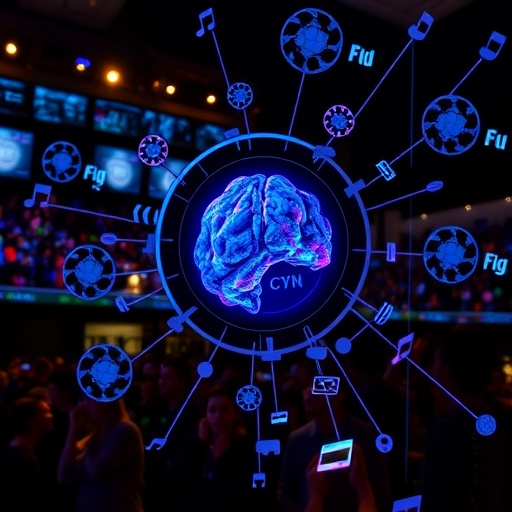The integration of artificial intelligence into various domains has transformed traditional methodologies. In recent advancements, convolutional neural networks (CNNs), known for their prowess in image and signal processing, have taken center stage in evaluating educational practices, specifically in the realm of singing. In this thrilling research, Zhang (2025) delves deep into how CNNs can be leveraged to assess the efficacy of singing instruction, shedding light on their potential to foster improved learning outcomes.
Traditionally, evaluating singing capabilities relied heavily on subjective assessments by instructors, often leading to inconsistencies. The introduction of CNNs, however, brings a paradigm shift by quantitatively analyzing various audio features of a singer’s performance. This research adopts a systematic approach to ascertain how the application of CNNs can refine our understanding of vocal training impacts and ultimately enrich the pedagogical landscape.
At the heart of this study is the idea that singing, an intricate art form, involves a myriad of factors such as pitch accuracy, rhythm, tone quality, and emotional expression. Each of these elements can be meticulously measured using audio data processed through a CNN framework. By converting musical performances into spectrograms—visual representations of the frequency spectrum of sounds—researchers can train the network to recognize patterns associated with successful vocal techniques and pedagogical strategies.
The methodology employed in the research was both innovative and rigorous. Initially, data collection involved recording performances from a diversely skilled group of singers before and after structured lessons. These audio samples were then converted into spectrogram images, capturing the essence of the singing quality in the frequency domain. Subsequent to the data preparation, the research team trained the CNN model on these images, aiming to recognize correlative features that distinguish proficient singing from less effective attempts.
One of the compelling aspects of CNNs is their ability to learn complex hierarchical features autonomously, without the explicit need for feature extraction, which is typically a manual and error-prone process. Through deep learning mechanisms, the CNN model progressively identified the nuanced characteristics that correlated with the quality of singing. This sophisticated analytical process allows for an objective assessment, which contrasts sharply with traditional evaluative methods based on individual instructor biases.
As the CNN model evolved through training, the results exhibited remarkable precision in discerning which instructional methodologies effectively enhanced vocal performance. The key findings indicated that certain teaching strategies positively impacted specific vocal attributes like vibrato and breath control, thus guiding educators in refining their instructional designs. This systematic evaluation empowers singing instructors to tailor their teaching approaches based on solid, data-driven insights rather than anecdotal evidence.
Furthermore, the implications of this research extend beyond just vocal training; they point toward a broader application of AI in arts education. The ability to quantitatively analyze performance data paves the way for similar methodologies across various artistic disciplines. Imagine a world where musicians, dancers, and even visual artists can utilize AI tools to receive feedback on their craft grounded in comprehensive data analytics. This trajectory holds exciting potential for revolutionizing artistic instruction.
In exploring the educational ramifications, the research prompts an inquiry into how institutions can integrate such technological advancements without undermining the art form’s inherent subjectivity. It emphasizes that while AI can significantly enhance evaluative processes, the human element remains irreplaceable, especially in creative domains. Balancing technology with artistic intuition is crucial as educators navigate the future of mixed pedagogical approaches.
To further foster collaboration between technology and the arts, Zhang suggests the establishment of interdisciplinary partnerships among educators, technologists, and researchers. These relationships could catalyze a more comprehensive understanding of how AI can actively contribute to teaching methodologies, ensuring that the intersection of art and science becomes a shared endeavor rather than a siloed effort.
As we contemplate the future of education in the arts, the pursuit of such innovative paradigms may lead to heightened engagement and success among learners. By adopting evidence-based practices stemming from AI analysis, singing instructors can provide a richer, more structured learning environment that nurtures talent and creativity while promoting measurable progress.
In conclusion, Zhang’s groundbreaking research on the application of convolutional neural networks in evaluating singing teaching effects marks a significant milestone in not only vocal education but also in the realm of arts pedagogy. By prioritizing data-driven approaches, this work exemplifies how technology can harmonize with artistry, providing illuminating insights that could redefine how we perceive teaching effectiveness.
Ultimately, as these innovative methodologies gain traction across diverse educational avenues, their contribution to enriching the learning experience cannot be overstated. Embracing the synergy between machine learning and arts education could cultivate a more nuanced appreciation for both disciplines, galvanizing future generations of artists and educators alike.
As researchers and educators continue to navigate this rapidly evolving landscape, the promise inherent in the integration of AI into education remains a thrilling realm of exploration, guaranteeing a dynamic future ahead.
Subject of Research: Application of convolutional neural network in the evaluation of singing teaching effect
Article Title: Application of convolutional neural network in the evaluation of singing teaching effect
Article References:
Zhang, J. Application of convolutional neural network in the evaluation of singing teaching effect.
Discov Artif Intell 5, 334 (2025). https://doi.org/10.1007/s44163-025-00549-6
Image Credits: AI Generated
DOI: https://doi.org/10.1007/s44163-025-00549-6
Keywords: Convolutional Neural Network, Singing Education, Teaching Effectiveness, AI in Education, Vocal Training
Tags: artificial intelligence in educationaudio feature analysis in singingCNNs in singing instruction evaluationconvolutional neural networks in education.effectiveness of singing instructionemotional expression in vocal performancesmachine learning in music assessmentpedagogical advancements in singing trainingpitch accuracy measurement in singingquantitative assessment of vocal performancerhythm evaluation using CNNstone quality analysis in music education





